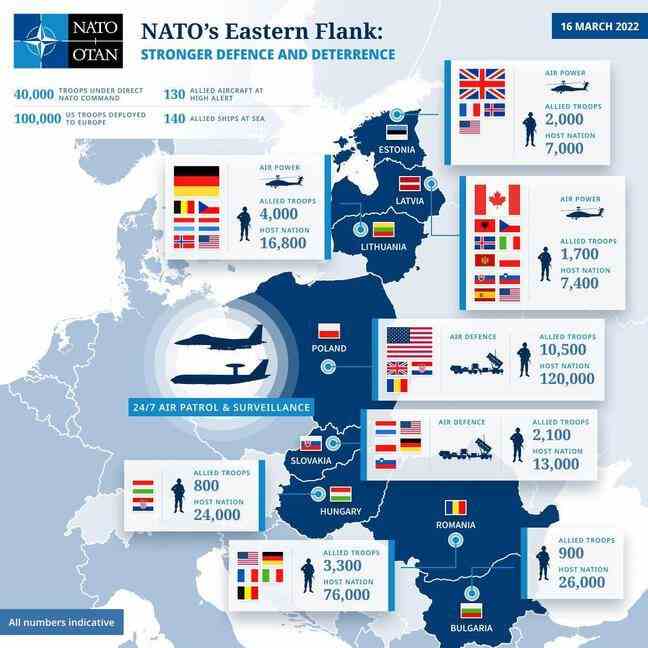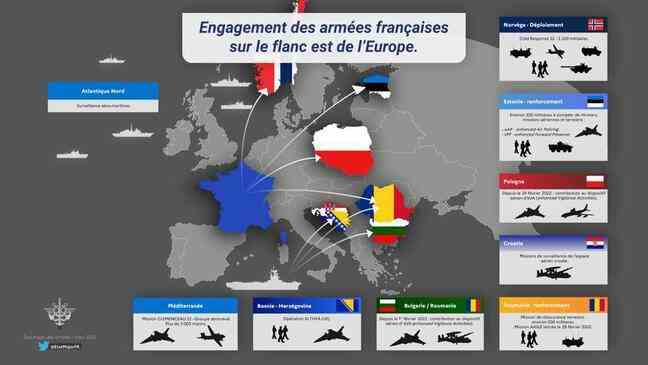In the car driving from Tallinn to the Soodla training camp, about forty kilometers from the Estonian capital, Colonel Eric Mauger insists: if France has decided to extend the presence of its troops in Estonia because of the war in Ukraine, the device already existed before.
“We had been there for a year, as part of a NATO mission called eFP (enhanced Forward Presence), “reinforced forward presence”, and we were to be relieved in March by Danish soldiers, explains the officer. superior, “Senior National Representative” of Lynx, the code name given to this participation in the eFP. Given the events, we wanted to strengthen this eFP system by maintaining a light infantry sub-group on site. »
A camp in the forest
The French soldiers who were present returned home safely, but were immediately replaced by the 7th battalion of alpine hunters from Varces (Isère), specialized in attrition combat in difficult environments. Mobilized in an emergency, he arrived on site on March 17. For a period for the moment… indefinite. If their presence were to be prolonged, the 250 soldiers of the company would themselves be relieved within three to four months.
The French soldiers are currently working alone in their corner. They have established a camp in the middle of the forest, in Soodla, and are in the reconnaissance phase of the terrain. The company will then fit into this famous eFP system. “It is a device that has existed since 2017, recalls Colonel Eric Mauger, it was created at the request of the three Baltic countries (Latvia, Lithuania, Estonia) and Poland, who wanted [déjà] that NATO’s eastern flank be strengthened. »
“Mountain troops to support armored vehicles”
These four eFPs are made up of one “battle group” per country, which corresponds to a battalion structure, ie approximately 1,000 men. A “framework nation” of NATO, always under the responsibility of the “host nation”, commands each of the “battle groups”: the United States in Poland, Germany in Lithuania, Canada in Latvia and the Great Britain in Estonia. Then “contributing forces” such as France and Denmark in Estonia, fit into this system.
The British “battle group” in Estonia is mainly armored, “but the terrain is very difficult, with wooded areas, swamps, sometimes inextricable for tanks, that’s why we proposed to bring seasoned mountain troops , to support the armored vehicles,” continues Colonel Eric Mauger. The famous alpine hunters of Varces, specialists in holding long-term positions in hostile environments. Especially in the cold.
The French contribution in Estonia is not limited to this company. As part of the eAP (enhanced Air Policing) device, “enhanced air policing”, France also sent four fighter planes, Mirage 2000-5s, to the scene. Departing from Luxeuil, they are based at Ämari airport. Together with four Belgian F-16 fighters, they carry out routine missions. They are also on alert to be able to take off and get to the area in fifteen minutes. “In all, we have 350 soldiers in Estonia” within a NATO system which has a total of around 2,000 soldiers in the country, assesses Colonel Pascal Lanni, spokesperson for the Chief of Defense Staff,
Aerial surveillance missions
Since February 24, NATO has generally strengthened its “defensive and dissuasive” posture on the entire eastern flank of Europe, with more than 25,000 soldiers deployed from Estonia to Bulgaria. A military reinforcement “which does not directly target Russia”, warns Colonel Lanni, even if, implicitly, “this reinforcement was decided because of Russia’s attack on Ukraine”. In such a tense context, you have to know how to weigh your words.

France contributes to these various measures deployed by NATO. “We participate in Poland, Bulgaria and Romania, with fighter planes leaving from Mont-de-Marsan and Saint-Dizier, and with tanker planes leaving from Istres, in surveillance and air defense missions ( eVA, enhanced Vigilance Activities), continues Colonel Lanni. NATO has organized a kind of aerial permanence in the Polish sky, and France contributes to it by taking certain slots alternately with other countries. »
“The Russian invasion of Ukraine is accelerating things”
In Romania, an alert battalion of around 550 Alpine hunters was deployed, as part of the mission Eagle, decided by the “Nato Response Force”, the rapid reaction force, of which France has taken command for the year 2022. “In the event of a crisis, this battalion will be integrated into the Romanian defense plans” indicates Colonel Lanni. France has also offered to become the “framework nation” for a fifth EFD mission in Romania. “It’s something that was already in the pipeline, the Russian invasion of Ukraine is accelerating things,” said Colonel Mauger.

In the Adriatic Sea, the mission of the carrier battle group, which was engaged against Daesh within the framework of Operation Chammal until early March, has just been reoriented towards maritime surveillance missions on the southern flank of the Alliance, and air defense missions – for its airborne group, over Romania, Croatia and from Bulgaria.
“Preparing for High Intensity Warfare”
“The principle is to strengthen NATO’s deterrent posture, with an objective of interoperability”, insists Colonel Lanni, that is to say “integration of our personnel” within the eFD missions. Colonel Mauger confirms: “We are used to working together, the Estonians, for example, deployed alongside us in Mali, so we know each other well, but there are always technical exercises which may differ from one nation to another, a way of issuing orders that can also vary…” All of this must be integrated by everyone as quickly as possible.
Finally, France is participating, with 3,200 soldiers, in the mega-military exercise taking place in Norway, cold-response.
Even if all this deployment of forces does not officially target a particular enemy, “you also have to be ready to intervene”, recognizes Colonel Lanni. “That means a lot of training, field reconnaissance, and preparation for high-intensity warfare. »

